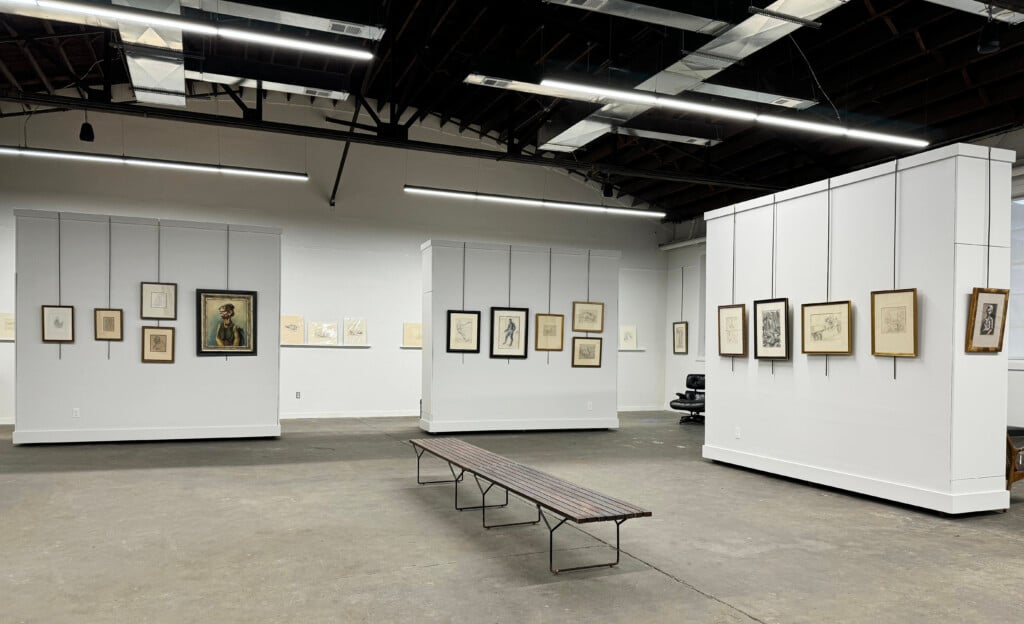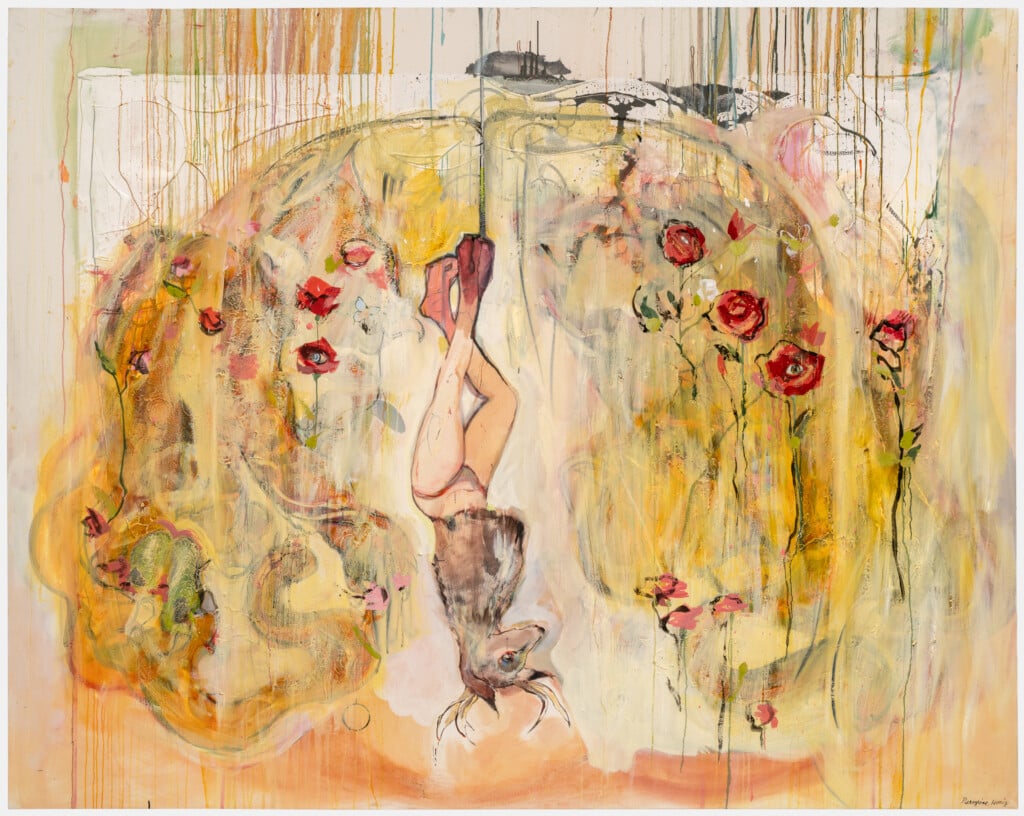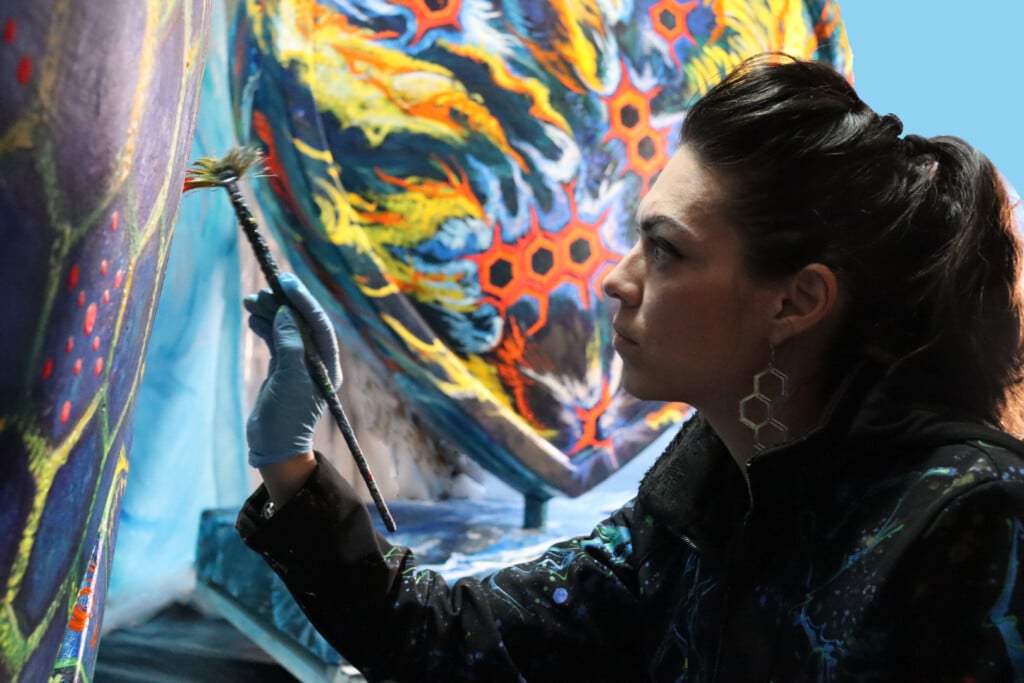A Wichita art exhibit generated heated reactions and raised provocative questions for venues
"A spectre was haunting Wichita — the spectre of feminism."

Sarah Alsaied: “Things I Learned from My Mother’s Kitchen.” Installation view in the exhibit “Gaze: Power and Politics.” (Ksenya Gurshtein)
A spectre was haunting Wichita — the spectre of feminism.
Or so you might have thought, based on the intense discussions that swirled on- and offline in the arts circles here surrounding the exhibit titled “Gaze: Power and Politics,” which ran through the end of May at the Mary R. Koch Arts Center, also known as Mark Arts, and which have stayed with me as food for thought since then.
Guest curated by Wichita photographer and arts educator Amanda Pfister, the show was timely and full of excellent artwork. Its historical reference point was an exhibition “dedicated to art by women” that took place 50 years ago, in 1973, at the Wichita Center for the Arts, Mark Arts’ predecessor.
To examine how much has or hasn’t changed in the past 50 years, Pfister invited 20 female artists to contribute their present-day perspectives. To the extent that the show had a message, the only overarching one was that living as a woman encompasses a diverse array of possible experiences and emotions, from joy and pride to sorrow and anger and much in between.
Most of the artists also live in Wichita or the Great Plains region. In bringing together work by so many artists from Kansas, as well as neighboring Oklahoma and Missouri, the exhibit highlighted the essential role Mark Arts plays in Wichita’s arts ecosystem. It is the biggest and most prominent venue in Kansas’ largest city to create regular exhibition opportunities for local and regional artists.
The other throughline one could notice in “Gaze: Power and Politics” was the curator’s and artists’ conscious effort to speak in the first person about their experiences and show vulnerability in doing so.
Of course, making yourself vulnerable by definition implies taking a risk.
Some of Wichita’s more conservative audiences took it upon themselves to prove that it is, apparently, still risky business in 2023 for women to talk publicly about their experiences of living as women.
By the third week of the exhibit’s run, Mark Arts, which hosts frequent large-scale private events inside its gallery and brings in community members who do not typically engage with contemporary visual art, began to receive complaints. Those upset with works in the exhibition — which featured content warnings at the entrance — reportedly yelled at, berated, and threatened art center staff. The sources of upset were artworks that acknowledged, among other things, that lesbian relationships, pregnancy loss, sex work, and sexual assault exist.

The exhibition title wall for “Gaze: Power and Politics” has its original sponsor logos removed. (Ksenya Gurshtein)
In early May, the logos of the exhibition’s lead sponsors, the Koch Family Foundation and Cox Communications, disappeared from the show’s title wall. A police officer appeared at the venue during public hours to offer security.
At the same time, one of the artists in the exhibition, Micala Gingrich Gaylord, chose to permanently modify “Seeing Inside,” one of her two pieces in the exhibition. Made up of gynecological examination tools arranged on the wall roughly in the shape of the artist’s shadow, the piece did not make for easy viewing. I’m not squeamish about human reproductive systems, but for me, it elicited viscerally unpleasant memories of being pinched and prodded in ways that are uncomfortable in every sense of the word. I can easily imagine someone who considers obstetrics to be a topic inappropriate for “polite” or “mixed” company finding the work far more upsetting than I did.
In early May, the artist was asked to temporarily conceal or remove her piece during a private event — a contingency stipulated in the contract artists sign when showing at Mark Arts. The artist took this to be an act of censorship and modified the work permanently by putting all the tools into a cardboard box that sat closed on top of a pedestal.
All these concurrent kerfuffles are an important impetus for a larger conversation about what roles art institutions play in their communities and what might be a reasonable baseline of expectations in a relationship between an institution and audience members who disagree with the art on view.
Throughout the run of this exhibition, Mark Arts’ leadership was admirably steadfast in fulfilling the commitment that it had made to the curator, the artists, and the patrons who see artistic expression as part of the sacrosanct American right to free speech. The art center also avowed a desire to serve as a space that invites visitors to consider difficult topics and varied viewpoints.
When I wrote to their leadership to express my concern that they might be considering closing the show early, the response I received read: “There is no doubt that the community is engaging in a dialogue about a variety of topics impacting women, and because of this, ‘Gaze’ is a success.”
At the same time, Mark Arts’ standard operating procedures — in place since 2018 when the center first opened — should, I think, be examined as an important contributing factor for why the institution might have adversarial relationships with both audiences and artists. This is the moment to consider what should change so that its business model is not directly at odds with its stated mission of being a “vibrant arts hub in Wichita and the region.”
Mark Arts’ assumption that an art gallery can seamlessly function as a rental event venue presupposes that the art in the space will always be a pleasant — or, at the very least, unobtrusive and inoffensive — background for wedding receptions, fundraising galas, corporate soirees, and other festive occasions whose planners do not get to pick the art in advance. Indeed, serving as amplifying decor in spaces used for public displays of ritual, power, or prestige is an important function that art has served historically.
Layered on top of that function, however, is a kind of purpose parfait whose strata date to different historical eras and discourses. Art serves numerous other uses: from memorialization of specific people and events to highly individualized expressions of artists’ identities; from formal experimentation to communal storytelling; from demonstrations of extravagant craftsmanship to exercises in creative resourcefulness, and so on.
A role that dominates a lot of “contemporary” art (and has done so in Western art since at least the 19th century) is that of critical reflection, intervention, or outright activism meant to provoke public discussion of challenging topics, underrepresented perspectives, and unresolved social problems.
This is, indeed, what many of the works in “Gaze: Power and Politics” attempted to do. It is the paradigm they function in; a feature and not a bug.
But if making viewers — all viewers — uncomfortable or perturbed at some level is a core intention of the works to which Mark Arts wants to be committed, wedging them into a space frequently dedicated to the maximum comfort of its users (I too wouldn’t want to look at speculums at my wedding) does a disservice to all parties involved, not least staff, who have to reconcile conflicting needs while worrying about the safety of the art with which they’ve been entrusted.

These paintings by Lydia Humphreys were based on workshops with survivors of sexual assault. Installation view in “Gaze: Power and Politics.” (Ksenya Gurshtein)
Lastly, what of dissent? If artists want to elicit big reactions from their audiences, rejection is bound to be one of those reactions. There is, indeed, a long history of vocal protest mounted against exhibitions by different groups for different reasons.
Knowing some of that history, I draw the conclusion that most people in the future, just like many in the present, will not look kindly on cases in which members of a powerful, culturally dominant group with ample access to money, spaces for self-expression, and communal connection try to shut down attempts by members of far less visible and under-resourced minorities to speak their personal truths.
Even given this, I still firmly believe that arts institutions have to expect occasional pushback against their work and create space for feedback to be heard in the context of dialogue and an effort to learn. A discussion panel originally planned and subsequently canceled at Mark Arts to accompany “Gaze: Power and Politics” would have offered a forum for at least the possibility of dialogue.
Not hosting it was, I believe, Mark Arts’ great missed opportunity with this project. The panel was held instead by the curator and several of the artists on the last day of the exhibition at Harvester Arts, a far smaller venue that caters to people already on board with the idea that art can and should be challenging.
That said, let’s go back to the first signs that things were amiss. Threats and intimidation? Immediate attempts at defunding? The presumptuous assumption that a secular institution funded by private money committed a grave error because it did not privilege someone’s particular set of religious beliefs?
Those all foreclose the possibility of dialogue. Contemporary arts institutions are grappling with how to do better at serving their diverse communities. Many genuinely want to hear and learn from their audiences.
As they do so, though, they are still staffed by human beings entitled to the same rights to safety, dignity, and courtesy that we grant all other civilian professions. Anyone who does not understand this is a disgrace to their cause.
Kansas Reflector is part of States Newsroom, a network of news bureaus supported by grants and a coalition of donors as a 501c(3) public charity. Kansas Reflector maintains editorial independence. Contact Editor Sherman Smith for questions: info@kansasreflector.com. Follow Kansas Reflector on Facebook and Twitter.





